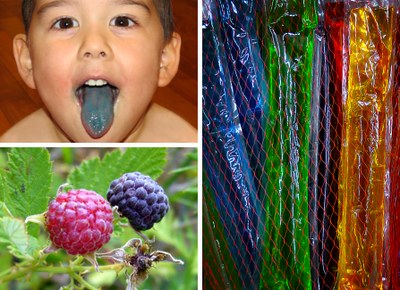What is a blue raspberry?
 How was your Halloween? Our Halloween was great—the kids had a fun time and collected lots of candy from our neighbors. Then I saw something weird—my boy had a blue tongue!
How was your Halloween? Our Halloween was great—the kids had a fun time and collected lots of candy from our neighbors. Then I saw something weird—my boy had a blue tongue!
His blue tongue was caused by blue raspberry candy. There are lots of blue raspberry snacks and juices on the market now.
Many of us are familiar with red, purple and even yellow raspberries, but what is a blue raspberry?
The blue raspberry originated in a laboratory, not on a farm. It started when makers of ice pops had more red flavors (cherry, strawberry, raspberry and watermelon) than shades of red dye. Kids who wanted a cherry ice pop, for example, could not figure out which red ice pop to select.
Raspberry pops originally used a dark red dye (FD&C Red No. 2) but it was later banned by the FDA as a possible carcinogen. The ice pop makers found Brilliant Blue dye (FD& C Blue No. 1) sitting on the laboratory shelves and the blue raspberry was created—along with blue tongues.
Its flavor mimics the flavor of blackcap raspberry Rubus leucodermis, a wild berry most of us have never seen or eaten (bottom left photo).
There is no such thing in nature as a blue raspberry. Even if you find a blue raspberry product with natural flavors it probably doesn’t have any actual raspberry flavor. Less expensive juices such as apple and orange are more commonly used in these products.
Source: Matt Soniak. What the heck is blue raspberry? http://mentalfloss.com/article/29273/what-heck-blue-raspberry. Accessed online on November 10, 2015, Photos courtesy of Tom Kalb, arbyreed and Zoya Akulova.





